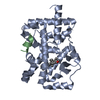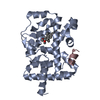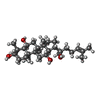[English] 日本語
 Yorodumi
Yorodumi- PDB-7w3q: Crystal structure of RORgamma in complex with natural inverse agonist -
+ Open data
Open data
- Basic information
Basic information
| Entry | Database: PDB / ID: 7w3q | ||||||
|---|---|---|---|---|---|---|---|
| Title | Crystal structure of RORgamma in complex with natural inverse agonist | ||||||
 Components Components |
| ||||||
 Keywords Keywords | TRANSCRIPTION / inverse agonist | ||||||
| Function / homology |  Function and homology information Function and homology informationcellular response to sterol / T-helper 17 cell differentiation / regulation of steroid metabolic process / ligand-modulated transcription factor activity / Peyer's patch development / positive regulation of circadian rhythm / T-helper cell differentiation / RUNX3 Regulates Immune Response and Cell Migration / oxysterol binding / negative regulation of thymocyte apoptotic process ...cellular response to sterol / T-helper 17 cell differentiation / regulation of steroid metabolic process / ligand-modulated transcription factor activity / Peyer's patch development / positive regulation of circadian rhythm / T-helper cell differentiation / RUNX3 Regulates Immune Response and Cell Migration / oxysterol binding / negative regulation of thymocyte apoptotic process / regulation of fat cell differentiation / RNA polymerase II intronic transcription regulatory region sequence-specific DNA binding / locomotor rhythm / aryl hydrocarbon receptor binding / cellular response to Thyroglobulin triiodothyronine / regulation of lipid metabolic process / regulation of glucose metabolic process / Synthesis of bile acids and bile salts / Synthesis of bile acids and bile salts via 27-hydroxycholesterol / Endogenous sterols / adipose tissue development / Synthesis of bile acids and bile salts via 7alpha-hydroxycholesterol / lymph node development / cellular response to hormone stimulus / Recycling of bile acids and salts / transcription regulator inhibitor activity / : / positive regulation of adipose tissue development / Regulation of lipid metabolism by PPARalpha / peroxisome proliferator activated receptor signaling pathway / regulation of cellular response to insulin stimulus / xenobiotic metabolic process / BMAL1:CLOCK,NPAS2 activates circadian expression / SUMOylation of transcription cofactors / Activation of gene expression by SREBF (SREBP) / response to progesterone / nuclear receptor binding / negative regulation of smoothened signaling pathway / circadian regulation of gene expression / mRNA transcription by RNA polymerase II / Heme signaling / Transcriptional activation of mitochondrial biogenesis / PPARA activates gene expression / Activated PKN1 stimulates transcription of AR (androgen receptor) regulated genes KLK2 and KLK3 / Cytoprotection by HMOX1 / Nuclear Receptor transcription pathway / Transcriptional regulation of white adipocyte differentiation / DNA-binding transcription repressor activity, RNA polymerase II-specific / RNA polymerase II transcription regulator complex / nuclear receptor activity / sequence-specific double-stranded DNA binding / : / HATs acetylate histones / MLL4 and MLL3 complexes regulate expression of PPARG target genes in adipogenesis and hepatic steatosis / Interleukin-4 and Interleukin-13 signaling / transcription regulator complex / Estrogen-dependent gene expression / DNA-binding transcription factor activity, RNA polymerase II-specific / transcription coactivator activity / protein dimerization activity / nuclear body / RNA polymerase II cis-regulatory region sequence-specific DNA binding / DNA-binding transcription factor activity / protein domain specific binding / chromatin binding / regulation of DNA-templated transcription / regulation of transcription by RNA polymerase II / chromatin / positive regulation of DNA-templated transcription / negative regulation of transcription by RNA polymerase II / positive regulation of transcription by RNA polymerase II / protein-containing complex / zinc ion binding / nucleoplasm / nucleus / cytoplasm Similarity search - Function | ||||||
| Biological species |  Homo sapiens (human) Homo sapiens (human) | ||||||
| Method |  X-RAY DIFFRACTION / X-RAY DIFFRACTION /  SYNCHROTRON / SYNCHROTRON /  MOLECULAR REPLACEMENT / Resolution: 2 Å MOLECULAR REPLACEMENT / Resolution: 2 Å | ||||||
 Authors Authors | Tian, S.Y. / Li, Y. | ||||||
| Funding support |  China, 1items China, 1items
| ||||||
 Citation Citation |  Journal: To Be Published Journal: To Be PublishedTitle: Crystal structure of RORgamma in complex with natural inverse agonist Authors: Tian, S.Y. / Li, Y. | ||||||
| History |
|
- Structure visualization
Structure visualization
| Structure viewer | Molecule:  Molmil Molmil Jmol/JSmol Jmol/JSmol |
|---|
- Downloads & links
Downloads & links
- Download
Download
| PDBx/mmCIF format |  7w3q.cif.gz 7w3q.cif.gz | 69 KB | Display |  PDBx/mmCIF format PDBx/mmCIF format |
|---|---|---|---|---|
| PDB format |  pdb7w3q.ent.gz pdb7w3q.ent.gz | 48.3 KB | Display |  PDB format PDB format |
| PDBx/mmJSON format |  7w3q.json.gz 7w3q.json.gz | Tree view |  PDBx/mmJSON format PDBx/mmJSON format | |
| Others |  Other downloads Other downloads |
-Validation report
| Summary document |  7w3q_validation.pdf.gz 7w3q_validation.pdf.gz | 748.3 KB | Display |  wwPDB validaton report wwPDB validaton report |
|---|---|---|---|---|
| Full document |  7w3q_full_validation.pdf.gz 7w3q_full_validation.pdf.gz | 751.8 KB | Display | |
| Data in XML |  7w3q_validation.xml.gz 7w3q_validation.xml.gz | 12.3 KB | Display | |
| Data in CIF |  7w3q_validation.cif.gz 7w3q_validation.cif.gz | 16.4 KB | Display | |
| Arichive directory |  https://data.pdbj.org/pub/pdb/validation_reports/w3/7w3q https://data.pdbj.org/pub/pdb/validation_reports/w3/7w3q ftp://data.pdbj.org/pub/pdb/validation_reports/w3/7w3q ftp://data.pdbj.org/pub/pdb/validation_reports/w3/7w3q | HTTPS FTP |
-Related structure data
| Related structure data |  7w3pC  3l0lS S: Starting model for refinement C: citing same article ( |
|---|---|
| Similar structure data | Similarity search - Function & homology  F&H Search F&H Search |
- Links
Links
- Assembly
Assembly
| Deposited unit | 
| ||||||||
|---|---|---|---|---|---|---|---|---|---|
| 1 |
| ||||||||
| Unit cell |
|
- Components
Components
| #1: Protein | Mass: 28639.182 Da / Num. of mol.: 1 Source method: isolated from a genetically manipulated source Source: (gene. exp.)  Homo sapiens (human) / Gene: RORC, NR1F3, RORG, RZRG / Production host: Homo sapiens (human) / Gene: RORC, NR1F3, RORG, RZRG / Production host:  |
|---|---|
| #2: Protein/peptide | Mass: 1579.866 Da / Num. of mol.: 1 / Source method: obtained synthetically / Source: (synth.)  Homo sapiens (human) / References: UniProt: Q15596 Homo sapiens (human) / References: UniProt: Q15596 |
| #3: Chemical | ChemComp-97I / ( |
| #4: Water | ChemComp-HOH / |
| Has ligand of interest | Y |
-Experimental details
-Experiment
| Experiment | Method:  X-RAY DIFFRACTION / Number of used crystals: 1 X-RAY DIFFRACTION / Number of used crystals: 1 |
|---|
- Sample preparation
Sample preparation
| Crystal | Density Matthews: 2.47 Å3/Da / Density % sol: 54.92 % |
|---|---|
| Crystal grow | Temperature: 293.15 K / Method: vapor diffusion, hanging drop Details: 0.2M Magnesium chloride hexahydrate, 0.1M BIS-TRIS pH 5.5, 25% w/v Polyethylene glycol 3350 |
-Data collection
| Diffraction | Mean temperature: 100 K / Serial crystal experiment: N |
|---|---|
| Diffraction source | Source:  SYNCHROTRON / Site: SYNCHROTRON / Site:  SSRF SSRF  / Beamline: BL17U1 / Wavelength: 0.97918 Å / Beamline: BL17U1 / Wavelength: 0.97918 Å |
| Detector | Type: ADSC QUANTUM 315r / Detector: CCD / Date: Jun 27, 2020 |
| Radiation | Protocol: SINGLE WAVELENGTH / Monochromatic (M) / Laue (L): M / Scattering type: x-ray |
| Radiation wavelength | Wavelength: 0.97918 Å / Relative weight: 1 |
| Reflection | Resolution: 2→57.45 Å / Num. obs: 21321 / % possible obs: 100 % / Redundancy: 12.2 % / Rmerge(I) obs: 0.168 / Rpim(I) all: 0.071 / Rrim(I) all: 0.183 / Net I/σ(I): 11.1 |
| Reflection shell | Resolution: 2→2.11 Å / Rmerge(I) obs: 1.392 / Num. unique obs: 3027 / Rpim(I) all: 0.603 |
- Processing
Processing
| Software |
| ||||||||||||||||||||||||||||||||||||||||||||||||||||||||||||
|---|---|---|---|---|---|---|---|---|---|---|---|---|---|---|---|---|---|---|---|---|---|---|---|---|---|---|---|---|---|---|---|---|---|---|---|---|---|---|---|---|---|---|---|---|---|---|---|---|---|---|---|---|---|---|---|---|---|---|---|---|---|
| Refinement | Method to determine structure:  MOLECULAR REPLACEMENT MOLECULAR REPLACEMENTStarting model: 3L0L Resolution: 2→57.45 Å / Cor.coef. Fo:Fc: 0.953 / Cor.coef. Fo:Fc free: 0.938 / SU B: 4.426 / SU ML: 0.123 / Cross valid method: THROUGHOUT / σ(F): 0 / ESU R: 0.181 / ESU R Free: 0.176 / Stereochemistry target values: MAXIMUM LIKELIHOOD Details: HYDROGENS HAVE BEEN ADDED IN THE RIDING POSITIONS U VALUES : REFINED INDIVIDUALLY
| ||||||||||||||||||||||||||||||||||||||||||||||||||||||||||||
| Solvent computation | Ion probe radii: 0.8 Å / Shrinkage radii: 0.8 Å / VDW probe radii: 1.2 Å / Solvent model: MASK | ||||||||||||||||||||||||||||||||||||||||||||||||||||||||||||
| Displacement parameters | Biso max: 114.07 Å2 / Biso mean: 45.132 Å2 / Biso min: 27.42 Å2
| ||||||||||||||||||||||||||||||||||||||||||||||||||||||||||||
| Refinement step | Cycle: final / Resolution: 2→57.45 Å
| ||||||||||||||||||||||||||||||||||||||||||||||||||||||||||||
| Refine LS restraints |
| ||||||||||||||||||||||||||||||||||||||||||||||||||||||||||||
| LS refinement shell | Resolution: 2→2.052 Å / Rfactor Rfree error: 0 / Total num. of bins used: 20
|
 Movie
Movie Controller
Controller


 PDBj
PDBj












